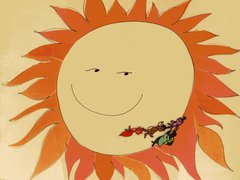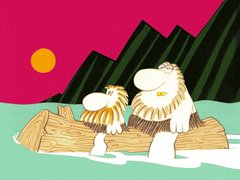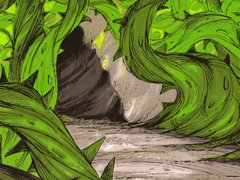In 1961 William Van Horn graduated from the California College of Arts and Crafts as a graphic designer. However, he felt attracted to animation. Soon he found a job at the studio of Imagination, Inc. in San Francisco.

Here Bill was mainly concerned with inking, i.e., transferring the pencil drawings to the cels, and coloring; partly he also made background drawings. In addition to 8 ad spots he was involved in the production of 4 episodes of the cartoon series “The Hunter” which were broadcast country-wide as part of NBC’s show “King Leonardo And His Short Subjects.”
A first milestone was the film “The Smell Of Wax” which was produced by Moulin Studios. Bill did the major part of the layout and all backgrounds; character animation was done by John Crow. This cartoon, which also was Bill’s first theatrical film, dealt with bullfighting in 1920s Spain and was based on a true incident.
After this promising start William Van Horn had to suspend his animation career because he was drafted for his army service. When he returned to San Francisco in 1964 he first worked as a graphic designer at The Smith Company and freelanced for several animation studios.
For Walter Landor Associates he contributed to 6 films between 1965 and 1967, mostly commercials.
At Mills Animation / Communication Films he made 8 advertising films in 1966. In this studio he had the opportunity to meet Disney veterans Bob Carlson and John Freeman.

In 1967 Bill found a job at a studio where he stayed for the next eight years: Davidson Films, Inc. He became art director of the animation department. However, there were no clear-cut fields of duty at the little studio with its twelve employees, so Bill frequently took over the complete production of a film. This included drawing the storyboards, layout, backgrounds, animation and camera work, sometimes also speaking the dialogs. At first inking and coloring were part of his duties, later the pencil drawings were xeroxed directly onto the cels and coloring was done by an external studio. Cutting and sound editing were the only aspects of film-making which Bill was never involved in.
It was at Davidson that Bill began a prolific collaboration with talented animator Mitchell Rose who had a crucial influence on his artistic development. The bad quality of the screenplays often made it necessary to rephrase the dialogs. Later Van Horn wrote several screenplays himself.
All in all Bill was involved in 90 films at Davidson, most of them educational shorts for distribution through schools and other institutions. His works received numerous awards, among them five CINE Golden Eagles and two silver medals at the Venice Children’s Film Festival.
In 1975 Van Horn and two partners bought out the Davidson studio which they renamed Aesop Films, Inc. Basically, they continued Davidson’s line of short educational pictures.

In 1976 Aesop Films acquired an option on the novel “Mrs. Frisby And The Rats Of NIMH” by Robert C. O’Brien, planning to make it into a TV mini series. After several preliminary studies and conferences with animation legend Chuck Jones, however, nothing came of the project, so it was up to Don Bluth to make a very successful movie of the book some years later.
Economically Aesop Films did not do well due to the difficult market situation. After Van Horn had produced 15 cartoons for Aesop he and his partners decided to close down the studio in 1977.
From now on Bill spent most of his time writing and illustrating children’s books. He still did one last film project for Sparlin-Free Productions in 1979 when he and Mitch Rose wrote the screenplay for “The Reluctant Robot.” This was a 50-minute live-action film with several animated segments which were also produced by Rose and Van Horn. However, Bill was not satisfied with the result because the screenplay was heavily rewritten by the studio.
William Van Horn was involved in a total of 133 films during his 14 years in the animation business.
In this long time he learned many things which were very useful for his further career. Already the seven children’s books written by himself show Bill’s distinctive humor. You immediately detect a trained hand in the drawings, too.
But Bill’s comics profit most from his time in animation. The stories are funny and structured in an enthralling way. As in the animated cartoons you notice a continuing action in the comic panels. The speed of the comic heroes varies from lazy walks to fast-paced activities which nearly leave the drops of sweat behind. The characters are shown from different perspectives. Bill even uses varying camera angles to draw dialogs, soundwords and text boxes.

Today you can watch animated films around the clock on numerous TV channels everywhere in the world. However, the quality often leaves a lot to be desired. It is very unfortunate that Bill’s animated cartoons are nearly forgotten. His funny films certainly deserve to be broadcast again.
But maybe a time will come when these affectionate films will find their way back to the tubes.
